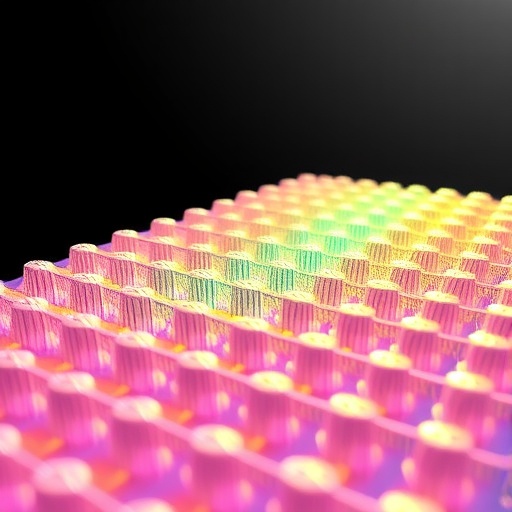In the rapidly advancing domain of photonics and metamaterials, researchers continually seek novel pathways to manipulate light with precision and efficiency unachievable by conventional means. A groundbreaking study published in Light: Science & Applications by Ahmed, Qi, and Chen heralds a significant leap forward in our understanding and engineering of metasurfaces, focusing on the integration of Debye relaxation phenomena and an innovative “folded path” concept. These developments fundamentally redefine dispersion engineering, a field pivotal for applications spanning telecommunications, imaging, and beyond.
Metasurfaces, ultrathin structures composed of arrays of subwavelength scatterers, have revolutionized optics by enabling unprecedented control over phase, amplitude, and polarization of light at the surface level. However, engineering their dispersive properties — how their response varies with frequency — remains a formidable challenge, especially when aiming for broadband or multifunctional performance. The new research addresses this bottleneck by exploiting the physical principles underlying Debye relaxation, traditionally a concept describing dielectric polarization decay in materials, and applying it ingeniously within nanostructured metasurfaces.
Debye relaxation typically characterizes how dipole moments within a material realign and dissipate energy over time when subjected to oscillating electromagnetic fields. By interpreting this temporal behavior in the context of spatial dispersion control, Ahmed and colleagues devised metasurface elements whose resonances can be tuned dynamically according to the temporal relaxation rates inherent in their material and geometric configuration. This approach enables designers to tailor frequency-dependent responses that were previously limited by static resonant architectures.
.adsslot_fxCntyzlwh{ width:728px !important; height:90px !important; }
@media (max-width:1199px) { .adsslot_fxCntyzlwh{ width:468px !important; height:60px !important; } }
@media (max-width:767px) { .adsslot_fxCntyzlwh{ width:320px !important; height:50px !important; } }
ADVERTISEMENT
Integrating Debye relaxation with the folded path design yields a rich dispersion landscape that pushes the envelope of what metasurfaces can accomplish. For instance, such devices can now exhibit tailored group delay dispersions, enabling the precise management of pulse broadening in ultrafast optics. This is critical for technologies relying on high-fidelity pulse shaping, including quantum communication systems, ultrafast microscopy, and high-speed data processing units.
The researchers utilized advanced computational modeling alongside nanofabrication techniques to validate their concepts. By fabricating metasurfaces composed of carefully designed dielectric and plasmonic elements, they experimentally observed the predicted dispersive behaviors, confirming the ability to control Debye relaxation-related dynamics at optical frequencies—an achievement previously thought to be restricted to microwave or terahertz regimes. This cross-frequency scalability opens new horizons for integrating such metasurfaces into existing photonic platforms.
Moreover, the folded path design introduces a paradigm shift by decoupling the physical thickness of the metasurface from its dispersive functionality. Traditionally, thicker materials were required to achieve significant group delay or phase shifts, but by folding optical paths within nanostructures, it is possible to mimic much larger optical path lengths within an ultrathin footprint. This miniaturization holds profound implications for on-chip photonics, where space and integration density are paramount.
From a theoretical standpoint, the intricate interplay between Debye relaxation processes and the geometrically folded paths contributes to a deeper understanding of light-matter interactions in nanostructured environments. The study lays foundational work toward unifying temporal relaxation phenomena with spatial optical engineering, suggesting new models that better predict and harness nonlinear and time-dependent optical responses essential for next-generation devices.
Another exciting prospect lies in quantum photonics, where precise dispersion control is vital for managing photon wavepacket shapes and entanglement timescales. The demonstrated approach provides a toolkit for designing metasurfaces that maintain coherence and minimize decoherence effects caused by mismatch in spectral components, propelling quantum communication and computing technologies forward.
While the study primarily focuses on visible to near-infrared ranges, the concepts presented are fundamentally scalable and adaptable to other regimes, including mid-infrared and terahertz. This spectral flexibility ensures that diverse scientific fields, from environmental sensing to medical diagnostics, can leverage these dispersion-engineered metasurfaces to build more sensitive and accurate instruments.
Furthermore, combining Debye relaxation with folded path engineering invites interdisciplinary collaboration across materials science, applied physics, and electrical engineering. Researchers are prompted to explore novel materials exhibiting tailored relaxation times and innovative metasurface patterns that maximize the folding efficiency, opening a fertile research landscape for innovation in photonic devices.
In conclusion, Ahmed, Qi, and Chen’s research delineates a compelling new frontier in metasurface technology, marrying fundamental physical insight with pioneering design principles. Their demonstration of Debye relaxation effects integrated with folded path optical trajectories sets the stage for a new generation of photonic components distinguished by remarkable dispersion control capabilities, compact designs, and functional versatility. As metasurfaces continue evolving, these findings will undoubtedly influence both theoretical frameworks and practical implementations, shaping the future of light-based technology.
Subject of Research: Dispersion Engineering in Metasurfaces through Debye Relaxation and Folded Optical Path Concepts
Article Title: Evolution of dispersion-engineered metasurfaces: Debye relaxation and folded path concept
Article References:
Ahmed, H., Qi, B. & Chen, X. Evolution of dispersion-engineered metasurfaces: Debye relaxation and folded path concept. Light Sci Appl 14, 223 (2025). https://doi.org/10.1038/s41377-025-01890-2
Image Credits: AI Generated
Tags: advanced light manipulation techniquesbroadband performance in optical devicesDebye relaxation phenomena in photonicsdielectric polarization in metamaterialsDispersion engineering in metasurfacesengineering dispersive properties of materialsinnovative folded path concept in opticsmultifunctional optical applicationsnanostructured materials for telecommunicationsphase and amplitude control in metasurfacesphotonics research breakthroughsultrathin metasurfaces for light manipulation





